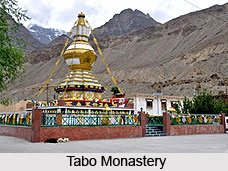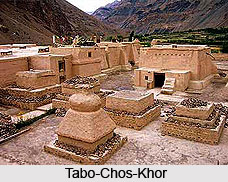 Tabo Monastery is situated in Tabo Village, approximately 46km southeast of Kaza at the height of 10,007 ft in Lahaul and Spiti district of Himachal Pradesh in North India. It is one of the oldest Buddhist pilgrimage situated in the Trans-Himalayas region. The Tabo monastery is a prehistoric monastery built in 996 A.D. It is the leading monastic complex in Tabo village, in the Spiti valley of Himachal Pradesh. It is considered as one of the most significant and sacred attractions of the region.
Tabo Monastery is situated in Tabo Village, approximately 46km southeast of Kaza at the height of 10,007 ft in Lahaul and Spiti district of Himachal Pradesh in North India. It is one of the oldest Buddhist pilgrimage situated in the Trans-Himalayas region. The Tabo monastery is a prehistoric monastery built in 996 A.D. It is the leading monastic complex in Tabo village, in the Spiti valley of Himachal Pradesh. It is considered as one of the most significant and sacred attractions of the region.
Importance of Tabo Monastery
The Tabo Monastery is also known as Tabo-Chos-khor, meaning `doctrinal circle`. The gompa houses 9 temples, 23 chortens, a monk`s chamber and an annex that houses a nun`s bedchamber. The nine temples namely, the `Temple of the Enlightened Gods`, the `Golden Temple`, the `Initiation Temple`, and the `Temple of Dromton`, are a few. The Temple of the Enlightened Gods, commonly known as the Assembly Hall, is the main highlight of the Tabo Monastery. The temple in its assembly hall houses the statue of `Vairocana`, one of the five spiritual sons of Buddha. The Initiation Temple has a large painting of Vairocana, surrounded by the eight Bodhisattvas. In this temple the monks receive their initiations to monkhood. At present, around 45 monks reside and study at the Tabo Monastery. Above the monastery, there are caves and cliff like structures which are used by the monks for meditation.
Architecture of Tabo Monastery
Tabo monastery houses delicate sculptures, stucco images and wall paintings, resembling the Ajanta paintings in Maharashtra. The iconography of this period in the temples also supports the bond that existed between the two cultures of India and Tibet. There are many priceless collections of thankas (scroll paintings), manuscripts, well-preserved statues, frescos and extensive murals which cover almost every wall. The paintings basically depict the culture and history of Himalayan region.  The monastery is in need of refurbishing as the wooden structures are aging and the thankas are fading. After the earthquake of 1975, the monastery was rebuilt, and in 1983 a new Assembly Hall was constructed by the 14th Dalai Lama and initiated the Kalchakara Festival. The monastery is protected by the Archaeological Survey of India (ASI) as a national historic treasure of India.
The monastery is in need of refurbishing as the wooden structures are aging and the thankas are fading. After the earthquake of 1975, the monastery was rebuilt, and in 1983 a new Assembly Hall was constructed by the 14th Dalai Lama and initiated the Kalchakara Festival. The monastery is protected by the Archaeological Survey of India (ASI) as a national historic treasure of India.
Festivals at Tabo Monastery
Many festivals are held in the Tabo Monastery. The monks perform traditional Buddhist and regional songs and masked dances. The most popular religious festival held here is the Chakhar Festival, which is dedicated to the peace and happiness of all. This is held every three years, usually during September or October.
Another thing which sets Tabo apart from other monasteries is the fact that it allows visitors to stay within its walls and get a personal experience of the life in the monastery.



















